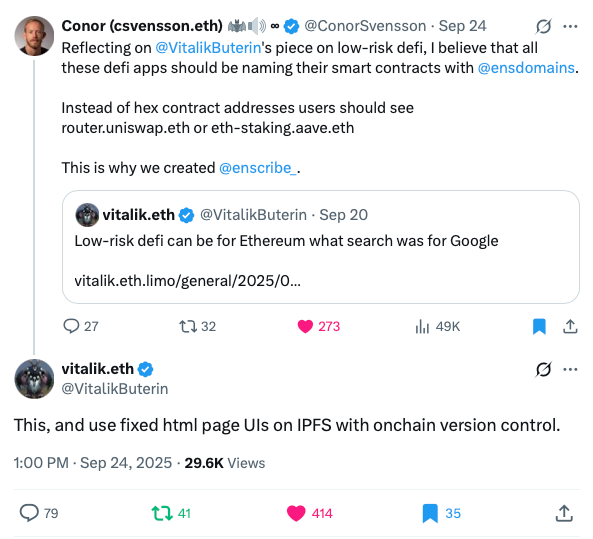Low-Risk DeFi Needs Human-Readable Smart Contracts
Vitalik Buterin recently published an essay on low-risk DeFi, arguing that Ethereum’s long-term strength won’t come from chasing the highest yields or the flashiest innovations. Instead, it will come from protocols that are boring, safe, and dependable, akin to how Google’s simple search box became the foundation of the modern web.
The core idea is straightforward: the future of DeFi depends not on yield farming and perps trading, but on building resilient, accessible financial tools that normal people can actually trust.
At Enscribe, we couldn’t agree more.
Why Low-Risk DeFi Matters
Most of DeFi today is still intimidating and opaque. Users are faced with hex contract addresses, complex front-ends, and endless warnings about scams or unaudited code. The reality is that even experienced developers struggle to keep track of what’s safe and what isn’t.
This is precisely the problem Vitalik is highlighting. Just as search unlocked the web by making it human-navigable, we need infrastructure that makes DeFi human-readable and transparent. Without it, only degens and developers will ever feel confident participating.
Names Over Hex
This is why we created Enscribe.
Instead of interacting with 0x5c63…ef7a or some random string of characters, users should see names like the following when they use Uniswap or Aave:
- router.uniswap.eth
- eth-staking.aave.eth
Names build trust. They create clarity that hex addresses cannot. A simple ENS-based naming layer makes it obvious what you’re interacting with, reducing the cognitive load and risk of mistakes for users.
When contracts are named, the experience of DeFi starts, users begin to feel they have greater agency over what they’re doing and
Aligning With Vitalik’s Vision
In response to our post on this very idea, Vitalik added an important companion point:

https://x.com/VitalikButerin/status/1970820664853741959
“This, and use fixed html page UIs on IPFS with onchain version control.”
That’s the other half of the equation. If contracts have an identity and aren’t simply hex addresses, we start building a DeFi ecosystem where trust can be earned through simplicity and durability.
Low-risk DeFi is about eliminating uncertainty at every layer:
- Names instead of hex addresses.
- Fixed, verifiable front-ends instead of mutable websites.
- Contracts with clear provenance and open verification.
Put together, this isn’t just “lower risk.” It’s a pathway to mainstream adoption.
The Road Ahead
Enscribe isn’t about creating yet another shiny DeFi product. It’s about providing the naming and verification layer that lets the entire ecosystem evolve into something usable and trustworthy.
Imagine a future where:
- Every DeFi protocol publishes named, verified contracts.
- UIs are simple, consistent, and immutable.
- Audits and provenance records are tied to contract names.
That’s the infrastructure Ethereum needs to onboard not just the next million, but the next hundred million users.
Vitalik’s essay was a reminder that chasing complexity isn’t the winning strategy. The winners will be the builders who make DeFi boring, reliable, and safe.
At Enscribe, we’re betting that naming is a critical step in that journey.
Happy naming! 🚀